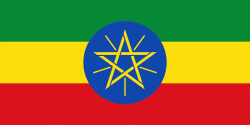Humera Airport (Humera Airport)
Humera Airport is an airport serving Humera, a town in the northwestern Tigray Region of Ethiopia. The name of the city and airport may also be transliterated as Himera or Himora.
Humera Airport is located at 13.83028°N, 36.88167°W, which is 59 km southeast of Humera (14.3°N, 36.61667°W). Humera's current airport opened in July 2009. It was constructed by the Ethiopian Airports Enterprise over a three-year period, at a cost of over 182 million birr (about 16 million U.S. dollars based in July 2009 exchange rates).
On 10 November 2020 during the Tigray War, the Ethiopian National Defense Force (ENDF) took over control of the airport from Tigray People's Liberation Front (TPLF) forces. As of 23 November 2020, Humera town itself was run by Amhara Region administrative and military forces.
Humera Airport is located at 13.83028°N, 36.88167°W, which is 59 km southeast of Humera (14.3°N, 36.61667°W). Humera's current airport opened in July 2009. It was constructed by the Ethiopian Airports Enterprise over a three-year period, at a cost of over 182 million birr (about 16 million U.S. dollars based in July 2009 exchange rates).
On 10 November 2020 during the Tigray War, the Ethiopian National Defense Force (ENDF) took over control of the airport from Tigray People's Liberation Front (TPLF) forces. As of 23 November 2020, Humera town itself was run by Amhara Region administrative and military forces.
| IATA Code | HUE | ICAO Code | HAHU | FAA Code | |
|---|---|---|---|---|---|
| Telephone | Fax | ||||
| Home page |
Map - Humera Airport (Humera Airport)
Map
Country - Ethiopia
 |
 |
| Flag of Ethiopia | |
Anatomically modern humans emerged from modern-day Ethiopia and set out to the Near East and elsewhere in the Middle Paleolithic period. Southwestern Ethiopia has been proposed as a possible homeland of the Afroasiatic language family. In 980 BCE, the Kingdom of D'mt extended its realm over Eritrea and the northern region of Ethiopia, while the Kingdom of Aksum maintained a unified civilization in the region for 900 years. Christianity was embraced by the kingdom in 330, and Islam arrived by the first Hijra in 615. After the collapse of Aksum in 960, a variety of kingdoms, largely tribal confederations, existed in the land of Ethiopia. The Zagwe dynasty ruled the north-central parts until being overthrown by Yekuno Amlak in 1270, inaugurating the Ethiopian Empire and the Solomonic dynasty, claimed descent from the biblical Solomon and Queen of Sheba under their son Menelik I. By the 14th century, the empire grew in prestige through territorial expansion and fighting against adjacent territories; most notably, the Ethiopian–Adal War (1529–1543) contributed to fragmentation of the empire, which ultimately fell under a decentralization known as Zemene Mesafint in the mid-18th century. Emperor Tewodros II ended Zemene Mesafint at the beginning of his reign in 1855, marking the reunification and modernization of Ethiopia.
Currency / Language
| ISO | Currency | Symbol | Significant figures |
|---|---|---|---|
| ETB | Ethiopian birr | Br | 2 |
| ISO | Language |
|---|---|
| AM | Amharic language |
| EN | English language |
| OM | Oromo language |
| SO | Somali language |
| TI | Tigrinya language |















